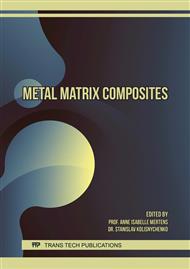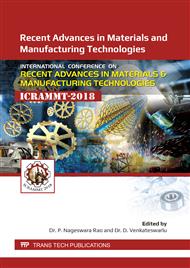[1]
Kok M, Ozdin K, Wear resistance of aluminium alloy and its composites reinforced by Al2O3 particles, J Mater Process Technol (2007) 183:301–9.
Google Scholar
[2]
H.J. Choi, S.M. Lee, D.H. Bae, Wear characteristic of aluminium-based composites containing multi-walled carbon nanotubes, Wear 270 (2010) 12–18.
DOI: 10.1016/j.wear.2010.08.024
Google Scholar
[3]
Surappa M K., Aluminium matrix composites: Challenges and Opportunities, SadhanaVol.28, parts 1 & 2, (2003) 319–334.
Google Scholar
[4]
Prasad S.V., Asthana R., Aluminum metal–matrix composites for automotive applications: tribological considerations, Tribology Letters, (2004) Vol. 17, No. 3.
DOI: 10.1023/b:tril.0000044492.91991.f3
Google Scholar
[5]
S.K. Ghosh, P.Saha, Crack and wear behaviour of SiC particulate reinforced aluminium-based metal matrix composite fabricated by a direct metal laser sintering process, Materials Design32 (2011) 139–145.
DOI: 10.1016/j.matdes.2010.06.020
Google Scholar
[6]
Minoru Taya, Richard J. Arsenault, Metal Matrix Composites: Thermomechanical behaviour, (1989) 1-5.
Google Scholar
[7]
Das DK, Mishra PC, Singh S, Pattanaik S. Fabrication and heat treatment of ceramic-reinforced aluminium matrix composites – a review, Int J Mech Mater Eng (2014) 1–15.
DOI: 10.1186/s40712-014-0006-7
Google Scholar
[8]
Mahendra, K.V., Radhakrishna, K, Characterization of Stir Cast Al—Cu—(fly ash + SiC) Hybrid Metal Matrix Composites, Journal of Composite Materials, vol. 44 Issue No. 8, (2010) 989-1005.
DOI: 10.1177/0021998309346386
Google Scholar
[9]
Rino JJ, Chandramohan D, Sucitharan KS, Jebin VD, An overview of the development of aluminium metal matrix composites with hybrid reinforcement. IJSR India Online ISSN (2012) 2319–7064.
Google Scholar
[10]
Archard JF, Contact and rubbing of flat surfaces, J Applied Physics (1953) 24:981–1008.
DOI: 10.1063/1.1721448
Google Scholar
[11]
Alaneme KK, Bodunrin MO, Mechanical behaviour of alumina reinforced AA 6063 metal matrix composites developed by two-step – stir casting process, Acta Tech Corvininesis – Bull Eng 2013, 6(3).
Google Scholar
[12]
Soda N, Wear of some F.F.C metals during Un-lubricated sliding part-1. Effect of Load, Velocity and Atmospheric pressure on wear, Wear, Vol.33, (1975) 1-16.
DOI: 10.1016/0043-1648(75)90219-7
Google Scholar
[13]
P. K. Rohatgi, S. Das, and T. K. Dan, Cast Al-graphite particle composites, a potential engineering material, Journal of the Institution of Engineers, vol. 67, no. 2 (1987) 77–83.
Google Scholar
[14]
Burwell J .T. Survey of possible wear mechanisms, Wear. Vol.1, (1958) 119-141.
Google Scholar



